Key takeaways:
- Reparations politics involves complex discussions on historical injustice, emphasizing the need for acknowledgment and recognition of past wrongs to facilitate healing.
- Listening sessions create vital spaces for community members to share personal narratives, fostering empathy and a deeper understanding of systemic issues.
- Community feedback is crucial for shaping reparations policies, as it highlights diverse experiences and needs that should inform advocacy efforts.
- Effective engagement strategies include creating safe spaces for dialogue, practicing active listening, and utilizing diverse media to express the complexities of reparative justice.

Understanding reparations politics
Reparations politics is a deeply nuanced and often contentious field that grapples with issues of historical injustice, inequality, and moral responsibility. When I first delved into this topic, I was struck by the emotional weight that accompanies discussions about reparations. How do we quantify pain and suffering that has spanned generations? This question made me reflect on conversations I’ve had with friends who have shared their family histories of hardship and resilience, illustrating just how personal this issue can be.
I remember attending a local community meeting where reparations were a hot topic. The varying perspectives and passionate voices made it clear how complex this dialogue is. Some argued for direct monetary compensation, while others emphasized the importance of educational opportunities and community investment. It made me realize that understanding reparations isn’t just about numbers; it’s about recognizing the lived experiences and histories that shape our present.
As I listen to these discussions, I often find myself pondering the question: What does justice look like in the context of reparations? I believe it’s essential to connect policies with the emotional narratives that give them meaning. For instance, hearing stories of hope amidst injustice pushes me to consider not only the ‘what’ but also the ‘why’ behind reparations politics. It’s a call for healing that ultimately seeks to bridge the divide between past wrongs and a more equitable future.
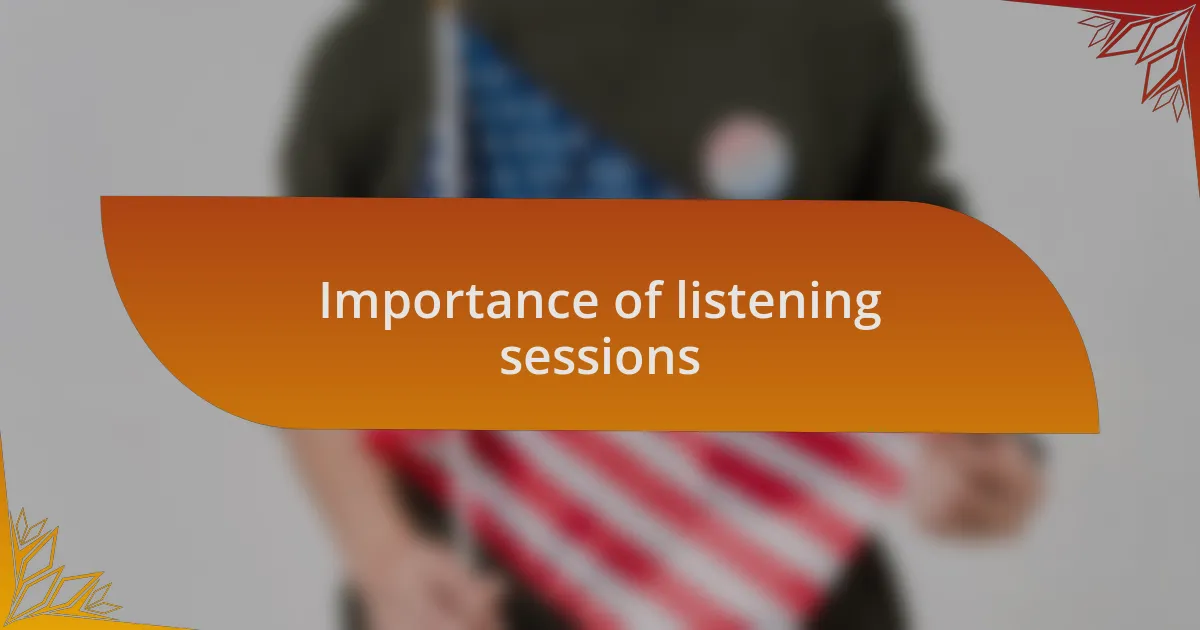
Importance of listening sessions
Listening sessions play a crucial role in the reparations conversation. I recall a gathering where community members shared their experiences—each story was a powerful testament to the impact of systemic injustice. It made me realize that these sessions are not just platforms for dialogue; they create spaces for empathy, allowing us to truly hear the voices behind the statistics.
In my experience, listening sessions help to demystify the reparations discourse. When participants share their personal histories, the theoretical becomes tangible. For instance, one elder recounted how her family’s denied access to education shaped their future. I found myself not only understanding her pain but feeling it. Isn’t it essential that we connect the abstract notion of reparations with these real, human experiences?
Moreover, these sessions foster a sense of community. I remember leaving one such event feeling a newfound sense of collective purpose. By actively engaging with one another’s stories, we begin understanding the shared struggle for justice. In essence, listening sessions are pivotal—they illuminate our path forward in the quest for meaningful reparations.

Key themes from listening sessions
Key themes from listening sessions often center around the intersection of personal narratives and systemic issues. I remember a session where a participant passionately spoke about the loss of family properties due to discriminatory housing policies. Hearing her frustration made it clear that these individual stories are not isolated; they ripple out to reveal patterns of inequality that many face. Isn’t it striking how history continues to impact lives today?
Another recurring theme is the call for acknowledgment and accountability. During one session, a young activist boldly questioned, “How can we expect healing without recognition of past wrongs?” This inquiry resonated with many, emphasizing the need for reparations not just as compensation but as a means of validating experiences that have long been ignored. I felt compelled to explore how recognition can lead to genuine reparative actions.
Finally, the notion of intergenerational trauma frequently surfaced. I recall a discussion led by someone who spoke about their grandmother’s struggles with mental health stemming from historical injustices. It struck me that the scars of the past are passed down, affecting the well-being of future generations. How can we begin to address these deep-seated wounds if we don’t first understand their origins? Listening sessions offer vital insights that can guide our understanding of these themes.
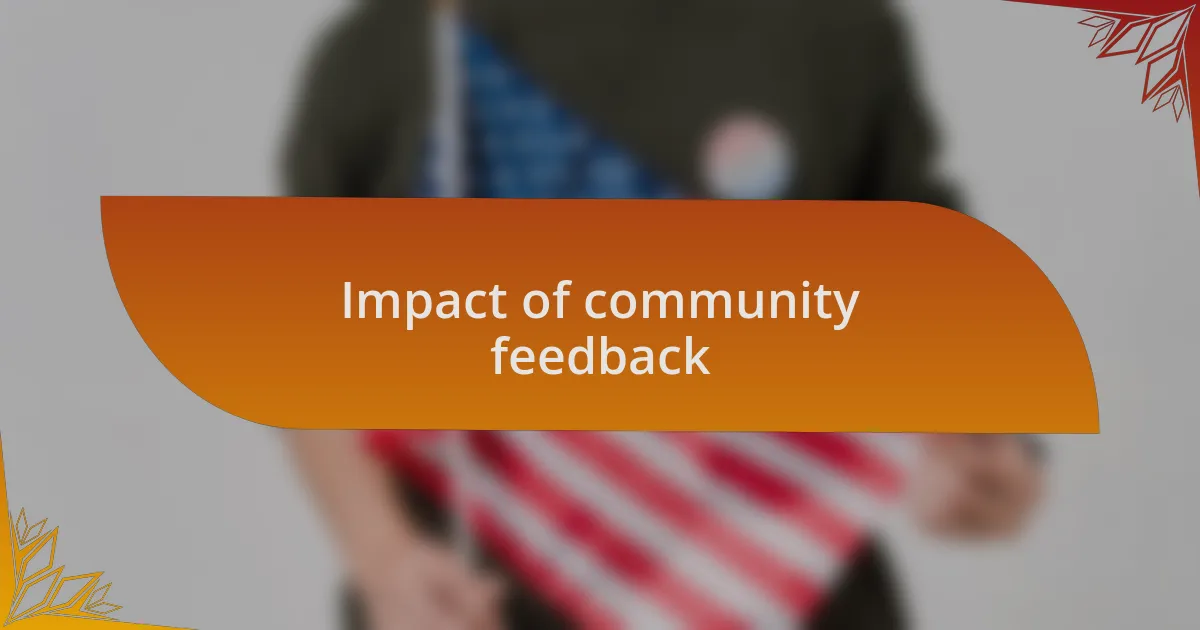
Impact of community feedback
Community feedback serves as a powerful catalyst for change. I remember one particular session where a participant shared how a lack of resources in their neighborhood limited opportunities for youth. The passion in their voice was palpable, and it made me realize how crucial it is to translate these comments into actionable policies. What if we truly listened and adapted our approaches based on these voices?
Each piece of feedback is like a thread weaving a larger tapestry of community needs and aspirations. Listening isn’t just a formality; it’s an essential tool that shapes the narrative of reparations politics. In one instance, a former mayor attended a session and was genuinely moved by the feedback about inaccessible health care. By actively listening, officials can identify critical issues that often go unaddressed, creating a path toward equitable solutions.
Moreover, I’ve found that community feedback can illuminate overlooked perspectives that challenge existing frameworks. At a session, someone discussed how their family history of land loss starkly contrasted with the dominant narrative around reparations. Two radically different lived experiences converging in thought showed me that understanding these perspectives is pivotal. How can we create policies that reflect the true diversity of experiences without community involvement? It’s a delicate balance, but one that is essential for fostering meaningful dialogue and responsibility.
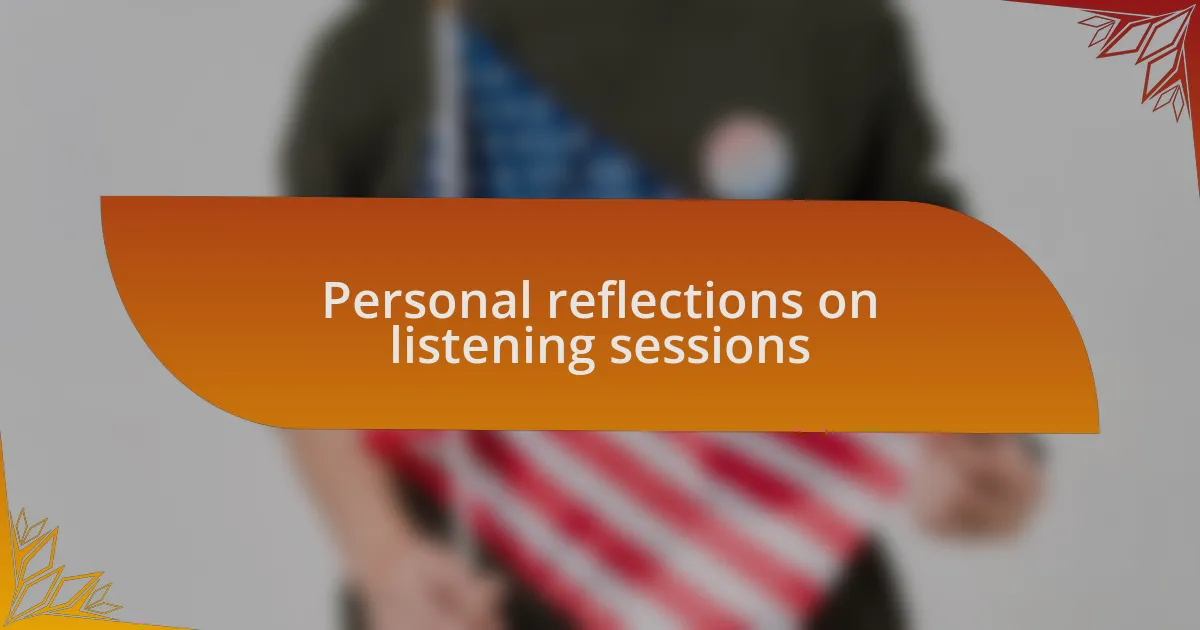
Personal reflections on listening sessions
Listening sessions stir something deep within me, igniting a genuine connection to the community’s struggles and hopes. I recall a poignant moment when a participant tearfully recounted their family’s journey through systemic barriers. Listening to their story reminded me that these sessions are more than just discussions; they’re a heartfelt exchange where pain meets possibility. How often do we find ourselves in spaces that allow such raw honesty?
As I reflect on these sessions, I can’t help but think about the power of shared narratives. One particular evening, a middle-aged woman spoke about her grandfather’s experiences with redlining, and her voice trembled with emotion. It struck me that we often overlook these personal histories in our quest for data and statistics, yet they define the very fabric of our understanding of reparations. If we dismiss these lived experiences, how can we ever claim to address the root of the injustice?
I’ve learned that every listening session carries the potential for transformation. During one gathering, a young activist highlighted the interconnectedness of various social issues, which prompted me to ponder: Are we truly considering all dimensions of reparations? These conversations remind me of the importance of inclusivity and the need for ongoing engagement. After all, the voices shared in these sessions have the power to guide our policies toward a more equitable future.
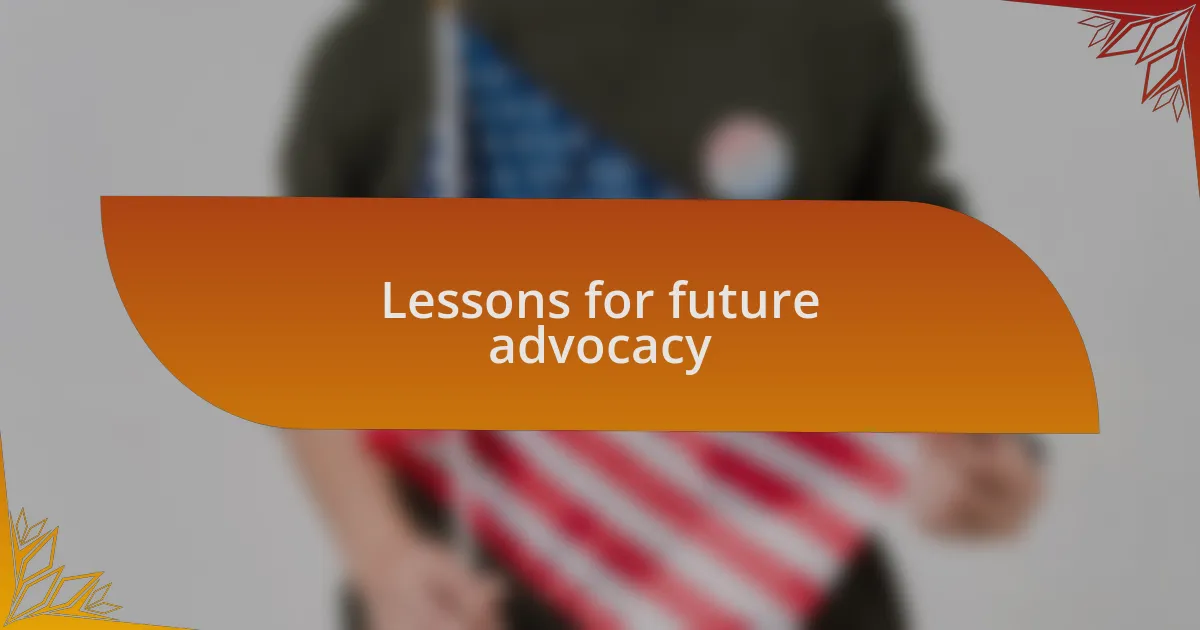
Lessons for future advocacy
Listening sessions have taught me that advocacy must be grounded in empathy and understanding. I remember one instance where a retired teacher shared her frustration about education disparities affecting her grandchildren. It made me realize that real change happens when we actively listen to those who are affected—when their stories become the compass guiding our advocacy efforts.
I also recognized the importance of framing reparations as not only a financial issue but a moral necessity. I once participated in a session where a longtime community leader expressed that reparations symbolize acknowledgment of past wrongs. This perspective resonated deeply with me. How can we advocate effectively if we don’t first honor the pain and resilience embedded in our communities’ narratives?
Moreover, the need for solidarity across different social movements has emerged as a critical lesson. I recall a moment when a participant, representing another marginalized group, drew parallels between their struggles and those related to reparations. It left me pondering—how can we build a stronger coalition if we treat these experiences as isolated? Cultivating these connections can amplify our voices and strengthen our collective action in future advocacy.
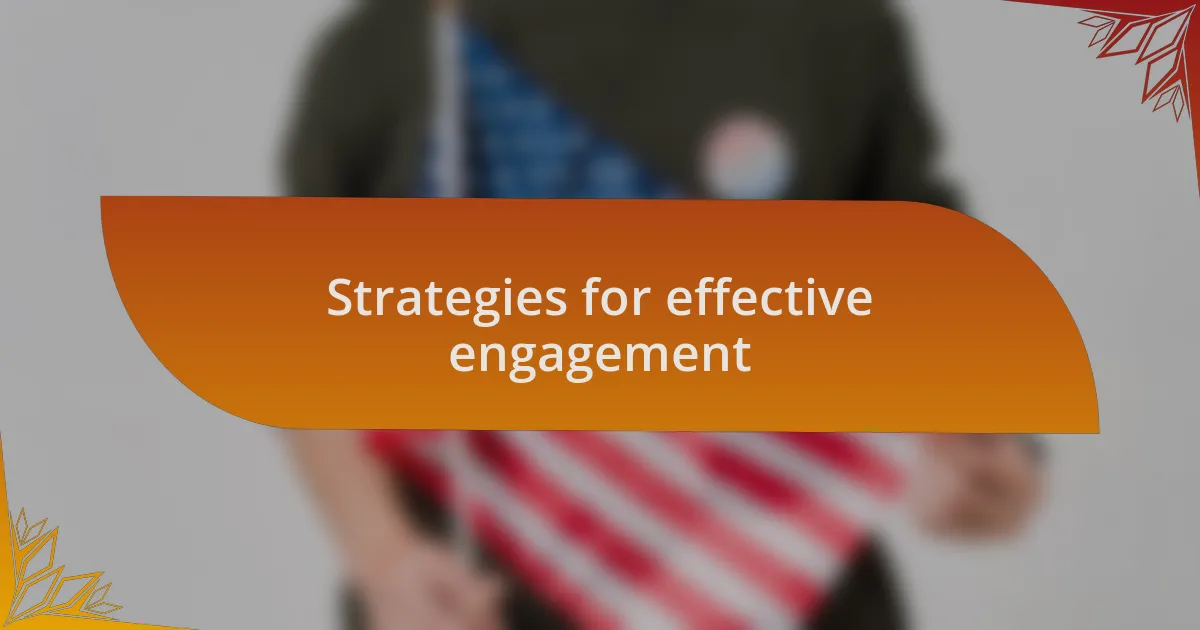
Strategies for effective engagement
To effectively engage stakeholders in the conversation on reparations, I’ve found that creating safe spaces for dialogue is crucial. There was a moment during one session when a young activist shared her apprehension about speaking up due to fear of being judged. This vulnerability opened the floor to others, and it became a profound reminder that when people feel secure and respected, their voices can spark revolutionary ideas. Are we doing enough to foster this environment in our discussions?
Active listening is another powerful strategy that I’ve observed firsthand. During a particular session, a participant eloquently articulated how their family had been impacted by systemic inequities for generations. As I sat and processed their story, I realized that genuine engagement requires us not only to hear but to absorb and reflect on the narratives shared. How often do we pause and truly absorb what others are saying before formulating our responses?
Additionally, incorporating diverse media formats can enhance engagement. In one listening session, we utilized visual storytelling, showcasing an art piece that encapsulated the essence of reparation struggles. The artwork allowed participants to express emotions that words sometimes cannot capture. Could this innovative approach help us communicate our mission more powerfully? By exploring different forms of expression, we can deepen our connection to the issues at hand while inviting broader participation in these critical conversations.